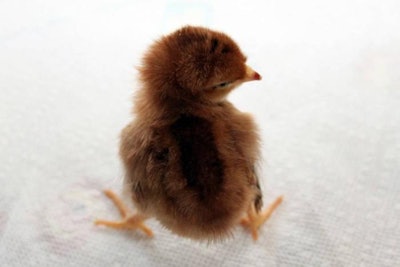
Incubation of chicks has not changed, as the rest of the poultry industry has done: "It is basically the same as in 1957," said Dr. Peter R. Ferket of NC State University during his presentation, "Early feeding: a key element in antibiotic-free production” at HatchTech’s event at the 2018 International Production and Processing Expo (IPPE).
It is important that incubation keeps up with the changes in poultry production and broiler genetics, and it must adapt to challenges like antibiotic-free production. While many changes can be made in alternative production systems, such as changing the feed formulation in an antibiotic-free operation, the key is before that in the perinatal and early nutrition stages of the newly hatched chick.
Dr. Ferket said that yield is at risk because "we are selecting more and more for yield." In the case of day-old chicks and current incubation systems, the bird does not use the yolk completely. However, proper feed and water intake encourage the use of that yolk.

Dr. Peter Ferket | Photo by Benjamín Ruiz
The first week after birth is a critical period for chicks, due to various factors such as immature thermal regulation or the transition from yolk to feed, among other things.
Adverse effects of delaying feeding
As newly hatched chicks need proper access to feed and water, the adverse effect of delaying feeding and access to water is that yolk use is reduced, delaying intestinal development. In this case, intestinal villi do not develop properly, which compromises the colonization of beneficial bacteria.
Water consumption is also essential for digestive function, metabolism and waste excretion. Obviously, without water, weight gain is reduced because birds do not eat, in addition to water helping digestion. Dehydration is a critical risk to bird quality and performance.
In the past, gel products have been introduced to the market, which in addition to nutrients, are a source of water. However, these gels are dehydrated inside the hatcher, so birds do not eat it.
Critically, if water and food are not provided immediately after hatching, lost performance cannot be recovered if those nutrients are provided four or five days later.
Having feed and water in the hatchery works, but it requires investing money. The hatchery is not a cost center – it is an investment.
A new incubation?
“We have to reinvent incubation," said Dr. Ferket, presenting Hatchtech's innovations in technology and explaining how the birds’ environment can be better controlled.
When it comes to producing without antibiotics, what stands out most about the Hatchtech system is the percentage of flocks that are produced without these important compounds. In traditional incubation systems, there is no light, no water and no food, but the Hatchtech system incorporates these three key inputs.
Joost te Heerdt of Hatchtech said that Hatchtech’s incubation technology has a perfect air flow and has a system in which eggshells fall to other containers, leaving 40 percent more space in the baskets used for transportation.
Additionally, animal welfare is improved because there are no chick counters or separators, so bird stress is reduced The basket used has small feeders on both sides, at a short distance from the birds.
Hatchtech also presented the HatchTraveller truck to transport newly hatched chicks, providing food, proper light according to the birds’ age and fresh air. The truck has computers that receive data, allowing for temperature to be adjusted.



















